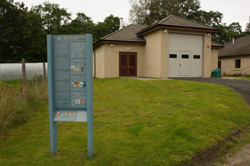 District heating is the use of a centralized boiler installation to provide heat for a number of buildings. This can use a heat only boiler, or the heat from a combined heat and power (CHP) plant.
District heating is the use of a centralized boiler installation to provide heat for a number of buildings. This can use a heat only boiler, or the heat from a combined heat and power (CHP) plant.
Boilers to burn woodfuels such as wood chips and pellets tends to be physically larger and more expensive than equivalent gas or oil boilers. This is partly as a result of the physical requirements for a high temperature combustion environment and transporting the solid fuel. As boilers get larger however the disparity with gas and oil boilers becomes comparatively smaller, and so woodfuel becomes more economically attractive, especially for installations of the scale of a few hundred kW.
District heating makes use of these cost advantages, as well as the administrative benefits of using a single boiler installation to provide heat to a number of buildings. These might be a number of individual houses, blocks of social housing, local council offices, a school, etc.
District heating is much more common in some European countries than in the UK. In Denmark for instance district heating provides around 60% of heating. However there are now a number of successful district heating schemes in the UK, both using fossil fuels and biomass.
A typical district heating installation consists of a highly insulated “heat main” of flow and return pipes distributing hot water (or steam) past all buildings which might be connected. A junction point allows easy connection to each building, from which hot water can be taken from the main to a heat exchanger (heat substation) within each building. The heating circuit within the building is thus isolated from the heat main. Temperature measurement of the flow and return lines, plus a flow meter (together forming a heat meter), allow the actual heat usage within each building, or even apartment, to be separately measured, and delivered heat billed for accordingly. Remote meter reading by modem, secure web interface or drive-by are all possible, as are remote diagnostics to ensure reliable operation.
In Austria there is a well established protocol for introducing a district heating scheme to a village or district. Farmers can form a co-operative to sell wood chips in the form of heat by installing and operating a district heating plant, operating as an Energy Servies Company (ESCO).
District heating can be provided using the co-generated heat from electrical power generation in a Combined Heat and Power (CHP) installation. This can increase the overall efficiency of power generation by a factor of three or more.
